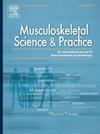Weight-bearing asymmetry during sit-to-stand following total hip arthroplasty: A scoping review
IF 2.2
3区 医学
Q1 REHABILITATION
引用次数: 0
Abstract
Background
Individuals with hip osteoarthritis tend to offload their involved limb during sit-to-stand. However, it is unclear whether these weight-bearing asymmetries persist following total hip arthroplasty (THA). The purpose of this scoping review was to map and summarize the evidence describing weight-bearing asymmetry during the sit-to-stand task among individuals who had undergone unilateral THA.
Methods
A literature search was conducted using PubMed, CINAHL, SPORTDiscus, and Health Source databases to identify studies examining weight-bearing asymmetry among individuals who had undergone THA. Studies were included if they were published in a peer-reviewed journal, included participants who had undergone primary unilateral THA, and examined bilateral ground reaction forces (i.e. “weight-bearing”) during sit-to-stand.
Results
Seven studies met the eligibility criteria for this scoping review. All seven studies examined weight-bearing asymmetry among participants who had undergone THA (ranging from 10 weeks to 19 months prior). Each of these studies found that participants who had undergone THA tended to place greater load on their uninvolved limb, compared to their involved limb, during sit-to-stand. Four studies compared weight-bearing asymmetry for participants who had undergone THA to individuals without a history of THA (controls). Three of these four studies reported that participants who had undergone THA exhibited greater weight-bearing asymmetry compared to controls, while the remaining study found no difference in weight-bearing asymmetry between the THA and control groups.
Conclusions
Individuals who have undergone THA tend to offload their involved limb when performing sit-to-stands. These individuals also tend to exhibit greater weight-bearing asymmetries compared to those without THA.
全髋关节置换术后坐立时的负重不对称:一项范围回顾
背景:髋关节骨性关节炎患者在坐立过程中倾向于卸下受累肢体。然而,目前尚不清楚这些负重不对称是否会在全髋关节置换术后持续存在。本综述的目的是绘制和总结描述单侧髋关节置换术患者坐立任务中负重不对称的证据。方法使用PubMed、CINAHL、SPORTDiscus和Health Source数据库进行文献检索,以确定对THA患者负重不对称的研究。如果研究发表在同行评议的期刊上,则纳入研究,包括经历过原发性单侧THA的参与者,并检查了坐姿到站立时的双边地面反作用力(即“负重”)。结果7项研究符合本综述的入选标准。所有七项研究都检查了接受过THA的参与者(从10周到19个月不等)的负重不对称性。每一项研究都发现,在坐姿到站立的过程中,接受过全髋关节置换术的参与者倾向于对其未受累肢体施加更大的负荷。四项研究比较了接受过髋关节置换术的参与者和没有髋关节置换术史的参与者(对照组)的负重不对称性。这四项研究中有三项报告称,与对照组相比,接受THA的参与者表现出更大的负重不对称性,而其余研究发现THA组和对照组之间的负重不对称性没有差异。结论:做过全髋关节置换术的个体在进行坐立时倾向于卸下受累肢体。与没有THA的人相比,这些人也倾向于表现出更大的负重不对称。
本文章由计算机程序翻译,如有差异,请以英文原文为准。
求助全文
约1分钟内获得全文
求助全文
来源期刊

Musculoskeletal Science and Practice
Health Professions-Physical Therapy, Sports Therapy and Rehabilitation
CiteScore
4.10
自引率
8.70%
发文量
152
审稿时长
48 days
期刊介绍:
Musculoskeletal Science & Practice, international journal of musculoskeletal physiotherapy, is a peer-reviewed international journal (previously Manual Therapy), publishing high quality original research, review and Masterclass articles that contribute to improving the clinical understanding of appropriate care processes for musculoskeletal disorders. The journal publishes articles that influence or add to the body of evidence on diagnostic and therapeutic processes, patient centered care, guidelines for musculoskeletal therapeutics and theoretical models that support developments in assessment, diagnosis, clinical reasoning and interventions.
 求助内容:
求助内容: 应助结果提醒方式:
应助结果提醒方式:


